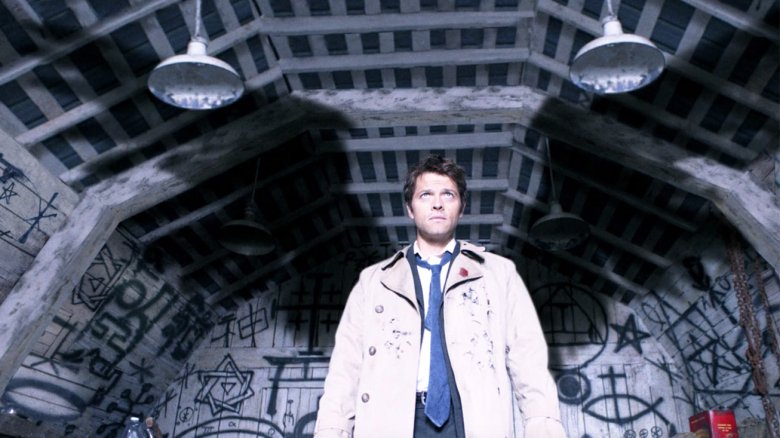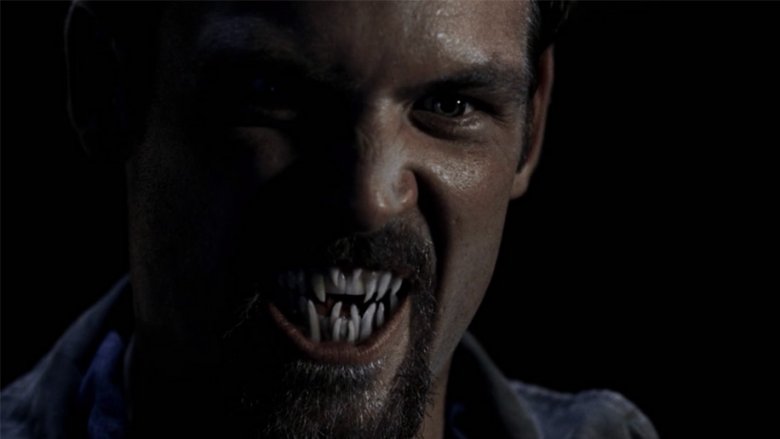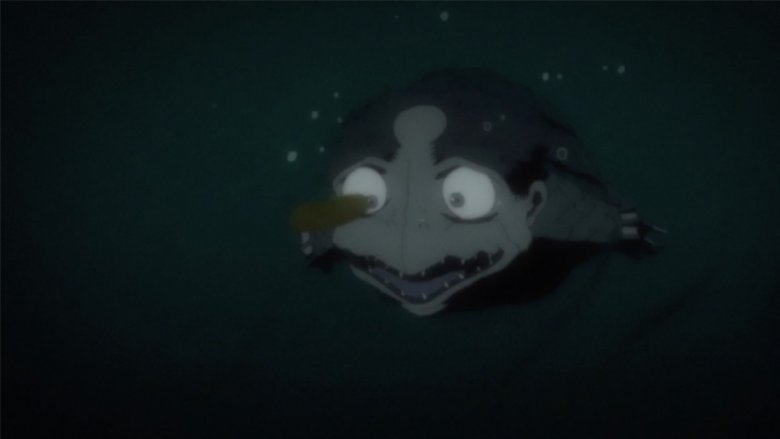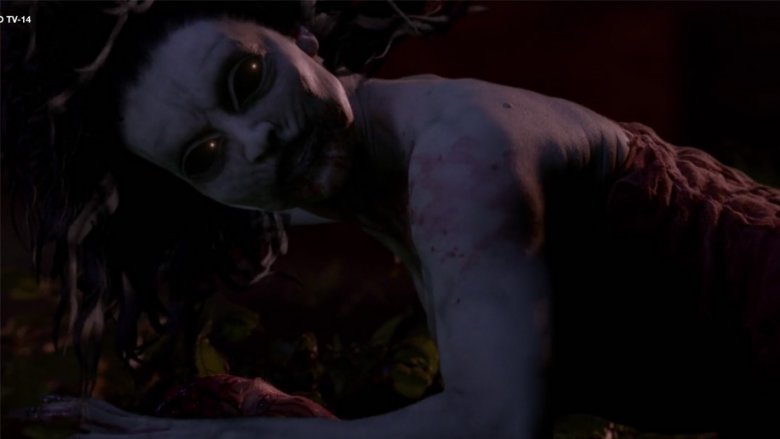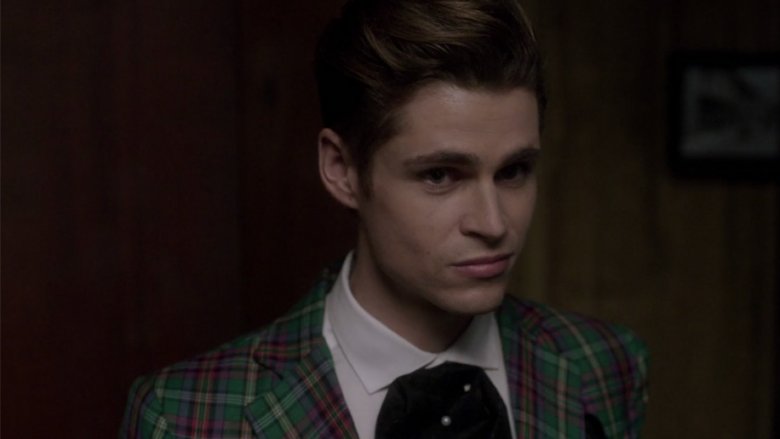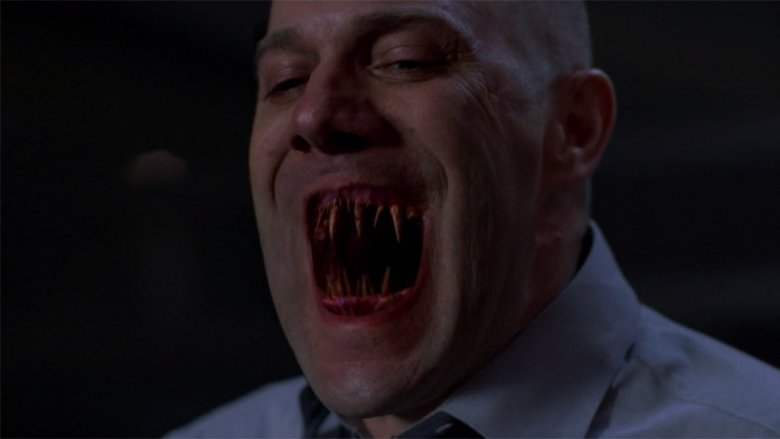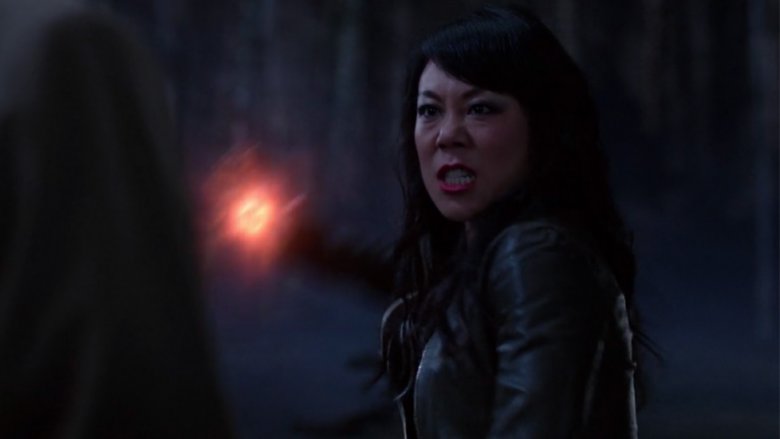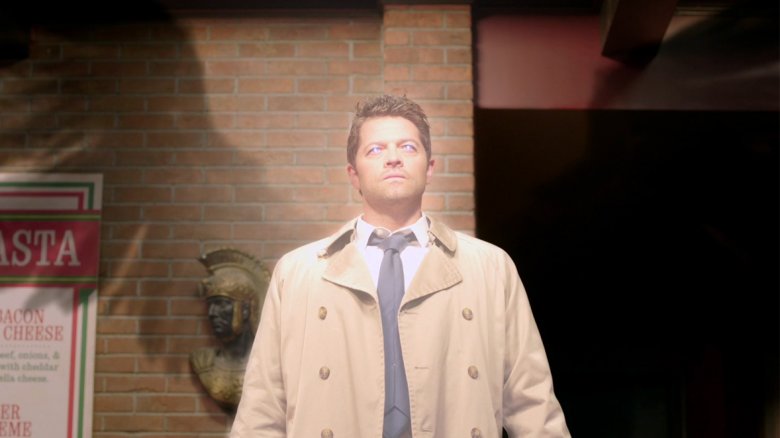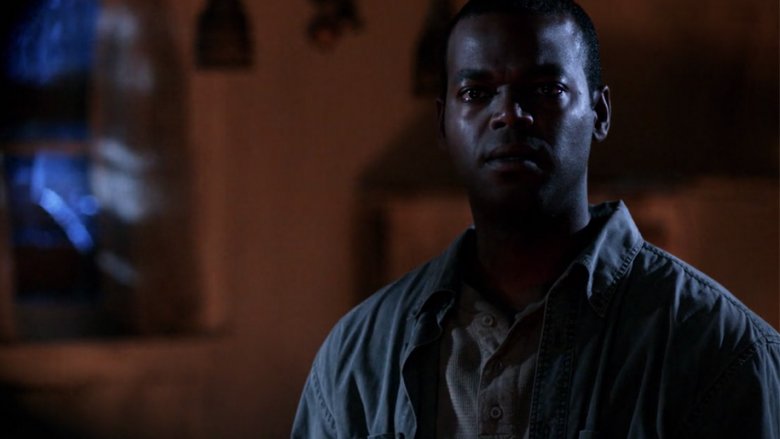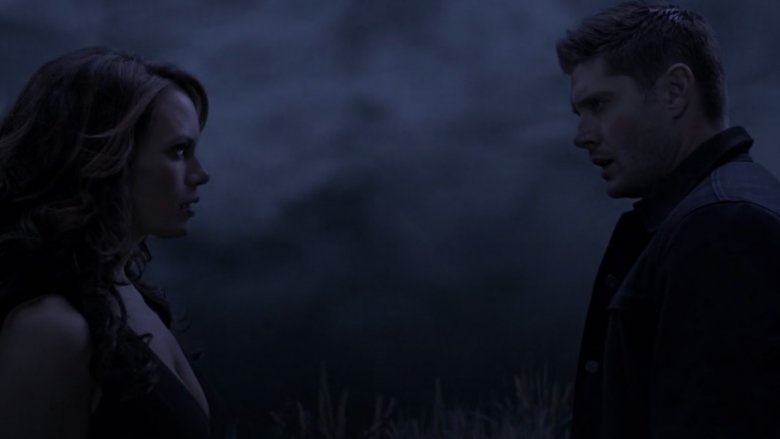Things Supernatural Gets Wrong About Mythical Beings
For 15 years, John Winchester's wayward sons have been hunting down spooky threats on Supernatural, taking on everything from werewolves to renegade fallen angels, and even a few gods. Of course, as Sam and Dean are well aware, knowing is half the battle, so they always go into their hunts armed with a few useful facts about whatever monster it is they're hunting down that week. Like, say, whether running it over with a Chrysler Impala is going to kill it, or if it's going to require a little bit of effort.
Needless to say, most of the Winchester boys' foes are drawn from folklore and mythology, but they're always a little bit tweaked to make for more exciting televised adventures. Do a little digging, though, and you might find out that those original legends are even weirder than the way they ended up on TV. Here are the things that Supernatural gets "wrong" about a few interesting mythical beings.
Vampires: down for the count
Ever since Bram Stoker dropped the hottest mixtape of 1897 and brought blood-sucking fiends to the world of pop culture, there have been countless vampire stories across all forms of media. As a result, it's nearly impossible to figure out what constitutes "real" vampire legends, and most stories have to spend at least a little time listing off what does and doesn't hold true from folklore.
Supernatural is no exception. As early as Season 1, viewers see John Winchester giving his sons (and the audience) a brief course in Vampire 101, explaining that crosses and holy symbols don't hurt them and sunlight won't turn them to dust, but as with most things, decapitating them will solve the problem tout de suite. That leaves plenty of folkloric vampire traits out in the cold, like shape-shifting, the aversion to running water or the idea that they're compelled to count things like a handful of seeds if it's thrown into their path, giving a would-be victim time for a hasty escape. Weirdly enough, Sesame Street got that one right.
While Supernatural's vampires can get by without stopping for a solid evening of counting grains of salt, the show actually did come up with its own completely bonkers set of weaknesses for its Draculas, including "Vamptonite," a toxic drug made from blood and corn syrup, and the Vampire Irradiation Gun, which harnesses the power of the atom to turn vampire blood into poison. Honestly, that one's so effective that it's kind of weird that the Winchesters don't just blast everything with radiation to see if it works, but to be fair, you don't even want to run the tiniest chance that you're going to have to deal with a leprechaun who is also a Hulk.
Kappa: hold onto your butts
Supernatural always has a good time with the more gimmicky episodes, from the one where Sam and Dean get magicked into the real world and find out that they're characters on a show called Supernatural to the one where they straight up just hung out with Scooby Doo. That's to be expected for a show that runs 15 years, though: you have to get a little weird to keep things interesting. That's why the next season of Grey's Anatomy will be taking place entirely on the moon.
Even with its famous gimmick episodes, though, the most buck wild piece of Supernatural television might just be the fact that there's a 22-episode anime series made for Japanese television from the same studio that did Ninja Scroll, Death Note, and the first season of One-Punch Man. It's largely an adaptation of the first two seasons, but perhaps unsurprisingly, the anime threw in a few well-known bits of Japanese folklore, too, like the Kappa.
In the show, the twist is that the Kappa is actually helpful and friendly, and the Winchesters have to convince some townsfolk to leave it alone. The more traditional mythology, however, depicts Kappa as pretty malevolent yokai who are prone to drowning their victims. Then again, drowning might be the best-case scenario — according to The Handbook of Japanese Mythology, "they also torment horses, sometimes by eviscerating them through the anus." Even by Supernatural standards, that's gonna be a yikes.
Banshee: bad reputation
On the show, banshees are ghostly women whose ear-piercing scream can drive her victims to kill themselves, after which she snacks on the frontal lobe. Even by Supernatural standards, snacking on the brains of people driven to suicide is pretty grim, and might just be the most brutal depiction of the creature in all of pop culture. It's also a pretty big departure from the banshee as originally known from Irish mythology, but Supernatural shouldn't feel bad about getting this one wrong, since pretty much everyone else does, too. In folklore, the banshee's loud scream is not harmful in itself. Instead, these particular spirits are wailing in sadness as they predict someone's death, or herald the death of an absent loved one. It's not the cause, it's a reaction of sadness, which makes the banshee a much more tragic figure.
In fact, a 17th century noblewoman named Ann Fanshawe wrote in her memoirs about encountering such a creature: "I saw, by the light of the moon, a woman leaning into the window, through the casement, in white, with red hair and pale and ghastly complexion: she spoke loud [... ] then, with a sigh more like the wind than breath she vanished, and to me her body looked more like a thick cloud than substance. I was so much frightened, that my hair stood on end, and my night clothes fell off." Lady Fanshawe later found out that this was the spirit of a murdered woman who was drowned in a nearby river, and who wailed with sadness whenever a member of the household was near death.
Sure, it seems unlikely — especially the part about how Lady Fanshawe was so scared that she was suddenly nude — but to be fair, Ann's memoirs also included the earliest recorded European recipe for ice cream. If you can't trust the lady who realized ice cream was something to write down, then who can you trust.
Sleipnir: horsin' around
Have you ever noticed that Supernatural mainly features evil creatures who just happen to be able to look like regular human beings, or at least as regular as the CW's Vancouver-based casting office can supply? It's almost as though the Winchesters' adventures are constrained by budgetary concerns.
Anyway, there are plenty of monsters for whom that makes perfect sense. Vampires and werewolves are only recognizably non-human some of the time, for instance, and more obscure creatures like Lamia are at least mostly human in appearance. For some, however, showing them as a straight up two-legged person is a monumentally bizarre choice, which is what viewers ran up against in Season 13, when a bunch of Norse gods showed up and started hanging around. Loki? Sure, we're used to seeing that dude walking around. Odin and Thor? They've been depicted as a couple of hairy human-ish fellas since at least the 13th century. But Sleipnir? Really?
As you may already know, Sleipnir, despite being someone that Loki gave birth to after a particularly eyebrow-raising round of shape-shifting, is not exactly man-shaped in the traditional mythology. He's a horse. A horse with eight legs. A horse with eight legs whose hooves struck the Earth and created a canyon 300 feet deep. On the show, he's just a dude who eats a carrot at one point, and while that's fine, we can't help but feel a little cheated that we didn't get a murder mystery where one of the suspects was just a gigantic spider-horse with no explanation.
Crocotta: Man's worst friend
Yet another Supernatural enemy who mysteriously takes a budget-friendly human form in order to prey ion its victims is the Crocotta, which shows up in season 3. The big difference here is that it when it feeds on people, it can unhinge its jaw and reveal a mouthful of needle teeth, which is a pretty neat effect.
Here's the thing, though: the "real life" Crocotta, lifted from East African and Indian folklore, is actually way easier to put in a live-action TV show than most of the other monsters that Supernatural has had to hammer into human form, like eight-legged horses or giant tiger monsters with backwards hands. In fact, they might even be easier to put on the show than dudes with creepy needle mouths, because the original Crocotta is... a dog. Like, that's it. It's just a dog.
Okay, so it's actually a dog that can talk and — like the show — mimics a human voice to lure its victims to their deaths, which has its origins in the hyena and the fact that they kind of sound like people laughing. Really, though, Air Bud technology has existed for decades and, again, they did a whole episode that crossed over a famous talking canine who is also a cartoon, so it's not like Supernatural couldn't have given us a talking, man-eating dog if they'd wanted to. Of course, then they would've had to deal with having an episode where our heroes kill a talking dog with knives, so it's probably for the best that they went with Needle-Mouth McGee instead.
Dagon: something's fishy
Sometimes, the only thing that carries over from myth and legend into Supernatural is a name. Such is the case for Dagon: on the show, it's a fairly standard-issue demon, albeit a pretty powerful one. As one of the Princes of Hell, thrown in with better-known demons like Azazel and Asmodeus, Dagon has all the powers you'd expect, plus the uncanny ability to melt a gun that can kill anything, which is the sort of thing that comes in awfully handy if you're going to spend your time fighting professional demon-killers.
Off the screen, Dagon is an ancient god who goes back about 4,300 years to ancient Mesopotamia, but is more more commonly known from a cameo appearance in 1 Samuel, chapter 5. If you're not up on the Old Testament, the short version is that the Philistines stole the Ark of the Covenant and brought it to a temple of Dagon, only to find that when they showed up the next morning, the statue of Dagon had fallen over, as though bowing to the Ark.
That might not be where Supernatural lifted the name, though, since — with all due respect to the First Book of Samuel — there's a much more pop culturally relevant place where it appears prominently. One of H.P. Lovecraft's earliest stories was 1917's Dagon, in which the narrator encounters both a monolith and one of Lovecraft's typically horrifying Deep Ones, describing it thus: "Vast, Polyphemus-like, and loathsome, it darted like a stupendous monster of nightmares to the monolith, about which it flung its gigantic scaly arms, the while it bowed its hideous head and gave vent to certain measured sounds." Be honest: you would pay a good amount of money to hear Jensen Ackles growl his way through calling something "Polyphemus-like," wouldn't you?
Angels: Castiel needs more eyes
Aside from Sam and Dean Winchester, the most prominent member of the cast of Supernatural is Castiel, the angel who fished Sam out of Hell back in Season 4 and became so beloved by fans that he wound up sticking around for the next decade. He's not the only angel to show up on the show by a long shot, and since they inhabit mortal forms while they're hanging out on Earth, it's rare that viewers ever actually get to see what they really look like. On those rare occasions that we do, however, we get beings composed of a brilliant light, complete with the occasional wings.
Presumably, this is because the show's budget would have a difficult time with gigantic wheels made of fire that are covered in a thousand eyes, because that's the actual description of God's heavenly pals that shows up in the Bible. Or one of them, at least — just like on the show, there are plenty of different kinds of angels described in books like Ezekiel, Daniel, and Isaiah, and most of them are way weirder than anything the CW could handle. Cherubim, for instance, are not the friendly naked babies that make people fall in love, they're creatures with four wings, brass hooves, and four faces: a lion, an ox, an eagle, and a human who may or may not resemble Misha Collins.
To bring it back to Cass, he's promoted to the Seraphim in Season 5, and while he cracks a joke about his true form being a hologram that's the size of the Chrysler Building, the capital-C Canonical description of the Seraphim is a little different. According to Isaiah, the Seraphim are relatively Misha Collins-shaped, but with six wings. Two for flying, two for covering their faces, and two for covering their "feet," which might be weird Bible slang for his ding-dang. That does not happen on the show, but there is definitely fan-fiction about that.
Raphael: Cool, not rude
While we're on the subject of angels, we have Raphael. While he's not the biggest troublemaker the Winchesters have encountered, he's popped up in various plots, and even once attempted to restart the apocalypse after it had been prevented. And yes: the fact that someone can literally attempt to cause the apocalypse and not be considered one of the Winchesters' worst foes should give you an idea of just how terrible their lives can get.
The Raphael we see on Supernatural couldn't be further from his canonical counterpart, though. The show depicts him as a severe, uncaring, and even cowardly, with little regard for humanity. In scripture, however, Raphael might be quick with a sarcastic comment, but is every bit as loyal as the other Ninja Turtles, and his skill with the sai is — wait. No, sorry. Wrong Raphael. Got our notes mixed up here.
Raphael the angel, as he appears in the Bible, is anything but uncaring. In fact, he's the angel specifically associated with healing, showing up rescue Lot from the destruction of Sodom in the book of Genesis, and is generally assumed to be the angel who stirs up a sort of first-century healing jacuzzi in the Gospel of John. He also shows up to help Tobias cure his father's blindness in the book of Tobit, which is considered canon by Catholicism and a few other denominations. Of course, that book also includes him going undercover for what is basically an Old Testament buddy cop comedy where he disguises himself as a dude named Azariah and at one point just bails to go chain up the demon Azazel, which is basically just an episode of Supernatural already.
Amara: sister, sister
With all the angels, demons, trips to Hell, and magic bullets inscribed with sigils lifted from the Lesser Key of Solomon, it's pretty obvious that Supernatural lifts a fair amount of material from Jewish and Christian theology and legends. Even God Himself shows up to hang out with the main characters with a frequency not seen since the Book of Genesis. The show does, however, deviate from canon in some pretty notable ways, and one of them was the big villain of Season 11.
If you read the Bible closely, you might notice that as it starts out, God isn't initially the only lowercase-g god, and that He even has different aspects who, according to some scholars, may have originally been thought of as an entire pantheon. It's not until the Good Book goes on that we see the shift to monolatry (the worship of one god who exists among many others, such as Baal and Dagon, who are mentioned in the OT) and eventually to monotheism (the belief in only one supreme God, with all others being depicted as pretenders to the throne). Even the most liberal examination of that process, however, omits one key thing that Supernatural digs up for its roster of baddies: God is not, traditionally speaking, depicted as having an older sister.
Supernatural, however, gives us Amara, and like many older sisters, she has to deal with far more strict punishments than her Little Brother. Like, say, being sealed away in a formless void since the dawn of time after a war against her Li'l Bro and His #squad of archangels. Admittedly, that's a bit harsher than what most older sisters experience, like being grounded for sneaking out, but it's the same basic idea, and definitely makes for an incredibly awkward visit at Christmas.
